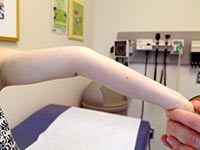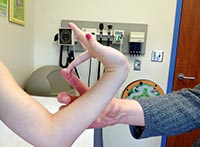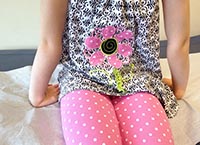A 10-year-old violinist comes in with complaints of joint pain for the past month. She has state-wide competition coming up next week, so has been practicing more than usual for the past several weeks. She placed second in the state last year in her age group, and is extremely focused on winning this year. She particularly complains of wrist and elbow pain after long practice sessions. She does not generally have pain in the morning. She is well appearing, and her general exam is normal. Joint exam does not find any swelling, though her elbows and wrists are tender to palpation. Both wrists extend past 90 degrees; both elbows extend past 180 degrees.

Photo 1

Photo 2

Photo 3
- This patient's elbow pain falls best into which major category of pain?
- Inflammatory
- Mechanical
- Bony
- Neuropathic
- Which of the following additional factors would be most consistent with this category of pain?
- The pain awakens her at night
- Wearing a flexible brace helps the pain
- The family has frequently seen erythema overlying the elbow
- Ice worsens the pain
- What would be the most helpful interventions to suggest to this driven young musician?
- Suggest she choose to play a different instrument
- Ice/rest between practice sessions, physical therapy
- Recommend a short burst of corticosteroid with a Medrol dose pack
- Recommend Lortab (acetaminophen/hydrocodone) to be used only for extreme pain until the competition is over.
-
Question 1
The correct answer is B - Mechanical
This patient has had the onset of elbow pain in the setting of significantly increased activity over the past month. Her pain worsens the more that she does. This pattern is most consistent with mechanical pain. In addition, she has no exam findings of joint inflammation, with no swelling or decreased range of motion. Rather than decreased range of motion, her exam finds hyperextension of her joints.
Inflammatory pain tends to improve with increased activity. Bony pain does not tend to correlate directly with the level of activity, nor does neuropathic pain.Question 2
The correct answer is B - wearing a flexible brace helps the pain
Mechanical pain tends to improve with rest. A flexible brace would help this patient by supplying support and some degree of stabilization of her lax joints.
Mechanical pain does not typically awaken children from sleep, this is more indicative of bony pain.
Erythema overlying the joint is not typically seen in mechanical pain. This is most often seen in septic joints, even more so than arthritic joints.
Ice tends to help mechanical pain. Worsening with ice can be seen in inflammatory joints, as this tends to cause increased joint stiffness.
Question 3
The correct answer is B - Ice/rest between practice sessions, physical therapy